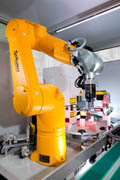9 January 2014
ES Technology Combines Laser, Vision and Robot Systems for Flexible Marking
 There are a growing number of applications where components used within the automotive industry require marking for identification and traceability. In certain cases a component may require marking in more than one place and in some instances a range of part types may also need to be processed. Faced with these problems, a leading UK manufacturer of automotive fuel systems turned to ES Technology for a highly flexible laser based marking and inspection system.
There are a growing number of applications where components used within the automotive industry require marking for identification and traceability. In certain cases a component may require marking in more than one place and in some instances a range of part types may also need to be processed. Faced with these problems, a leading UK manufacturer of automotive fuel systems turned to ES Technology for a highly flexible laser based marking and inspection system.
The concept developed by ES Technology for this application uses a combination of technologies to provide the highest levels of flexibility. Components are presented to the system in trays, delivered on a conveyor system, and a six-axis robot is used to pick the items individually from the tray and place them to a loading station on a 6 position rotary indexing table.
As the table indexes, the part which has just been loaded by the robot is checked by a vision system to determine the component profile and radial orientation. A further index presents the part to the laser marking station. Here the component is lifted from the table nest and rotated using motorised grippers to present it in the correct position for marking. With many components requiring marking in multiple positions, the motorised gripper systems are used to re-position the part between marking cycles.
The ES Technology system is designed to handle a range of component types and at the heart of system is a Rofin PowerLine 10E Air laser source, coupled with a fast focusing module.
The laser is used to produce 2D data matrix codes, and following the marking process a separate vision system is used to read and grade the 2D matrix codes. All good parts are returned to the original tray by the robot and any that are deemed to have failed the inspection process are segregated in a separate reject tray.
The system guarding enclosure has been designed for easy viewing whilst maintaining a safe working environment. The large interlocked access doors allow access for maintenance purposes and the machine control system offers an intuitive interface for the operator.
- Contact Information
- Name: Tim Millard
- Email: sales@estechnology.co.uk
- Website: www.estechnology.co.uk

